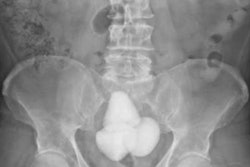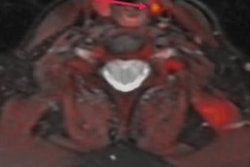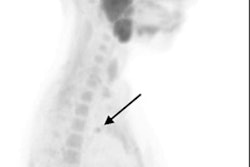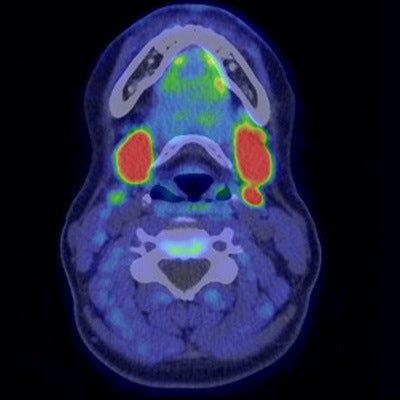
PET/CT imaging with carbon-11 (C-11) choline can help achieve surgical cures for patients with primary hyperparathyroidism after standard imaging approaches have failed, according to a study published October 11 in the journal Surgery.
Endocrine surgeons at the Mayo Clinic in Rochester, MN, explored whether C-11 choline PET/CT could identify abnormal parathyroid glands in patients who required further treatment after standard imaging and prior surgeries. The approach led to curative surgeries in 80% of patients, they found.
"C-11 choline PET/CT can be a useful adjunct for patients with failed conventional imaging and a prior unsuccessful operation," wrote corresponding author Dr. Melanie Lyden.
Primary hyperparathyroidism causes high calcium levels in the blood due to the overproduction of parathyroid hormone and can cause a variety of health problems, including osteoporosis and cardiovascular complications. Surgery (parathyroidectomy) is the most common treatment.
Traditional preoperative imaging to locate abnormal glands may include neck ultrasound, SPECT/CT with iodine-123 sestamibi, and 4D CT. However, all three of these conventional imaging modalities are unable to achieve 100% accuracy in localizing abnormal parathyroid glands, and their accuracy decreases significantly in the setting of reoperative parathyroidectomy where accurate localization is necessary to the success of the operation, the authors wrote.
In 2012, the Mayo Clinic received U.S. approval for the use of C-11 choline PET for restaging biochemically recurrent prostate cancer and noted in case reports that the C-11 choline radiotracer also appeared to accumulate in hyperfunctioning parathyroid cells. The group has since shown that the approach performs well compared to standard imaging approaches in hyperparathyroid patients prior to surgery.
In this study, the group explored whether C-11 choline PET/CT is effective in patients in whom other approaches had failed to identify the disorder and who perhaps as a result underwent unsuccessful initial surgery.
The researchers reviewed outcomes for 43 patients who received a C-11 choline PET/CT scan between 2017 and 2021 at the Mayo Clinic. Ultrasound, I-123 sestamibi, and 4D CT had failed to localize the disorder in most patients and 70% had prior operations at outside institutions. C-11 choline radiotracer was produced at the hospital's onsite cyclotron facility.
Out of the 43 patients, 33 (77%) had positive C-11 choline PET/CT findings, according to the results. Twenty-five patients proceeded to surgery, and of these patients, 20 (80%) achieved an intraoperative cure. Notably, 18 of the patients who proceeded to surgery (72%) had failed prior operations, the authors wrote. One patient had four prior failed operations, and five patients had two prior failed operations.
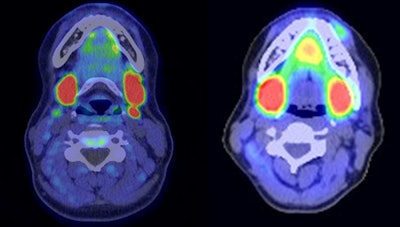 On the left, a C-11 choline PET/CT image used to identify an undescended left parathyroid gland posterior to submandibular gland; on the right, a comparative SPECT image that was unable to identify the gland. Image courtesy of Surgery.
On the left, a C-11 choline PET/CT image used to identify an undescended left parathyroid gland posterior to submandibular gland; on the right, a comparative SPECT image that was unable to identify the gland. Image courtesy of Surgery.Overall, in a highly selective cohort heavily skewed toward patients with negative conventional imaging and failed surgery, imaging analysis showed that C-11 choline PET/CT achieved a sensitivity of 64% and a positive predictive value of 72%, the authors wrote.
"C-11 choline PET/CT is a useful adjunct for parathyroid localization in a complex population of patients who have failed standard localization techniques that may include [ultrasound], I-123 sestamibi, and/or 4D CT," the authors wrote.
The authors noted several factors that may limit the widespread use of C-11 choline PET/CT. For one, C-11 choline has a short physical half-life of 20.4 minutes, which requires it to be produced and delivered onsite. To date, including Mayo Clinic, only Memorial Sloan Kettering and two nonuniversity centers offer C-11 choline PET/CT scans for primary hyperparathyroidism in the U.S.
Secondly, the current cost of a C-11 choline PET/CT scan is nearly double that of I-123 sestamibi and SPECT/CT, although recent Medicare changes have brought the cost down to match that of an FDG-PET/CT scan, the authors wrote.
Thus, it may be early to suggest routine inclusion of C-11 choline PET/CT imaging in the initial workup of primary hyperparathyroidism, they noted.
"However, it has shown promise as a powerful adjunct when conventional imaging modalities and exploratory operations have failed," Lyden and colleagues concluded.




